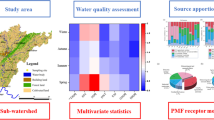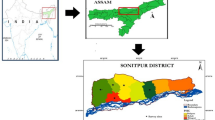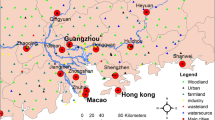Abstract
Receptor models are used to understand the attributes of groundwater contaminants by recognizing their sources and evaluating the contribution from each source to receptor concentrations. Two receptor models, Unmix and Positive matrix factorization (PMF), were applied to the data obtained from 41 sampling points on 20 parameters, in order to identify and apportion the pollution sources to groundwater quality in Peenya region of Bengaluru. Overall six and seven sources were identified by Unmix and PMF models, respectively. Most groundwater quality variables were found to be influenced primarily by pollution from chromium electroplating, sewage, geology of the area and lead acid battery manufacturing units located in the study area. The models could recognize significant sources adding to groundwater quality in the region with most of them being anthropogenic due to the presence of industrial activity. It was observed that both models gave good outcomes with regard to their capacity to repeat measured concentrations with fundamentally the same slopes in a large portion of the cases, yet with the PMF model demonstrating the best correlation and the nearest slope to unit. Receptor models are regularly applied to distinguish source contributions. The dissimilarities among the results of various models are essential to better interpret source apportionment.



Similar content being viewed by others
References
Ahada CP, Suthar S (2017) Hydrochemistry of groundwater in North Rajasthan, India: chemical and multivariate analysis. Environ Earth Sci 76(5):203
Ahmed N, Bodrud-Doza M, Islam ARMT, Hossain S, Moniruzzaman M, Deb N, Bhuiyan MAQ (2019) Appraising spatial variations of As, Fe, Mn and NO3 contaminations associated health risks of drinking water from Surma basin, Bangladesh. Chemosphere 218:726–740
Amarillo AC, Mateos AC, Carreras H (2017) Source apportionment of PM10-bound polycyclic aromatic hydrocarbons by positive matrix factorization in Córdoba City, Argentina. Arch Environ Contam Toxicol 72(3):380–390
APHA (2005) Standard methods for the examination of water and wastewater, 20th ed. American Public Health Association, Washington, DC
Basappa Reddy M (2003) Status of groundwater quality in Bangalore and its Environs. Report, Dept. of Mines and Geology, Bangalore: 44–52
Bhuiyan C, Singh RP, Kogan FN (2006) Monitoring drought dynamics in the Aravalli region (India) using different indices based on ground and remote sensing data. Int J Appl Earth Obs Geoinf 8(4):289–302
Bhuiyan MAH, Nandi S, Hossain MS (2007) Assessment of groundwater demand and supply for sustainable water resource management: a case study in Dhaka City. J Environ Sci (Dhaka) 5:9–20
Bhuiyan MAH, Dampare SB, Islam MA, Suzuki S (2015) Source apportionment and pollution evaluation of heavy metals in water and sediments of Buriganga River, Bangladesh, using multivariate analysis and pollution evaluation indices. Environ Monit Assess 187(1):4075
BIS-Bureau of Indian Standards (revised 2003) Drinking water specifications. IS: 10500: 1991. Bureau of Indian Standards, New Delhi
Brown SG, Eberly S, Paatero P, Norris GA (2015) Methods for estimating uncertainty in PMF solutions: examples with ambient air and water quality data and guidance on reporting PMF results. Sci Total Environ 518:626–635
Central Groundwater Board (1999) Hydrogeolgical report on Bangalore Metropolitan area, Karnataka: 12–14
CGWB-Central Ground Water Board (2012) Ground water information booklet-Dakshina Kannada District Karnataka, Ministry of Water Resources, Government of India: 44–46
Chaturvedi A, Bhattacharjee S, Mondal GC, Kumar V, Singh PK, Singh AK (2019) Exploring new correlation between hazard index and heavy metal pollution index in groundwater. Ecol Indic 97:239–246
Chen H, Teng Y, Li J, Wu J, Wang J (2016) Source apportionment of trace metals in river sediments: A comparison of three methods. Environ Pollut 211:28–37
Chen Y, Du W, Chen J, Hong Y, Zhao J, Xu L, Xiao H (2017) Chemical composition, structural properties, and source apportionment of organic macromolecules in atmospheric PM10 in a coastal city of Southeast China. Environ Sci Pollut Res 24(6):5877–5887
Cloutier V, Lefebvre R, Therrien R, Savard MM (2008) Multivariate statistical analysis of geochemical data as indicative of the hydrogeochemical evolution of groundwater in a sedimentary rock aquifer system. J Hydrol 353(3):294–313
CPCB-Central Pollution Control Board (2014) Report on assessment of environmental compliance in electroplating units at Bengaluru: 32–34
Das M, Kumar A, Mohapatra M, Muduli SD (2010) Evaluation of drinking quality of groundwater through multivariate techniques in urban area. Environ Monit Assess 166(1):149–157
DMG-Department of Mines and Geology (2003) Status of ground water quality in Bangalore and its environs. District groundwater brochure: 26–28
DMG-Department of Mines and Geology (2011) Groundwater hydrology and groundwater quality in and around Bangalore city: 67–69
Dragon K (2008) The influence of anthropogenic contamination on the groundwater chemistry of a semi-confined aquifer (the Wielkopolska buried valley aquifer, Poland). Water Resour Manag 22(3):343–355
Drever IJ (1997) The Geochemistry of Natural Waters, 3rd edn. Prentice Hall, Inc, Englewood Cliffs, pp 230–235
Gulgundi MS, Shetty A (2016) Identification and apportionment of pollution sources to groundwater quality. Environ Process 3(2):451–461
Gulgundi MS, Shetty A (2018) Groundwater quality assessment of urban Bengaluru using multivariate statistical techniques. Appl Water Sci 8(1):43
Guo X, Zuo R, Shan D, Cao Y, Wang J, Teng Y, Zheng B (2017) Source apportionment of pollution in groundwater source area using factor analysis and positive matrix factorization methods. Hum Ecol Risk Assess Int J 23(6):1417–1436
Henry RC (2003) Multivariate receptor modeling by N-dimensional edge detection. Chemom Intell Lab Syst 65(2):179–189
Henry RC, Kim BM (1990) Extension of self-modeling curve resolution to mixtures of more than three components: part 1. Finding the basic feasible region. Chemom Intell Lab Syst 8(2):205–216
Henry RC, Norris GA (2000) EPA Unmix 2.3. User guide
Hossain MA, Ali NM, Islam MS, Hossain HZ (2015) Spatial distribution and source apportionment of heavy metals in soils of Gebeng industrial city, Malaysia. Environ Earth Sci 73(1):115–126
Huang S, Rahn KA, Arimoto R (1999) Testing and optimizing two factor-analysis techniques on aerosol at Narragansett, Rhode Island. Atmos Environ 33(14):2169–2185
Jain CK, Bandyopadhyay A, Bhadra A (2010) Assessment of ground water quality for drinking purpose, district Nainital, Uttarakhand, India. Environ Monit Assess 166(1):663–676
Jain S, Sharma SK, Mandal TK, Saxena M (2017) Source apportionment of PM10 in Delhi, India using PCA/APCS, UNMIX and PMF. Particuology 37:107–118
Johnson CJ, Kross BC (1990) Continuing importance of nitrate contamination of groundwater and wells in rural areas. Am J Ind Med 18(4):449–456
Khalid S (2019) An assessment of groundwater quality for irrigation and drinking purposes around brick kilns in three districts of Balochistan province, Pakistan, through water quality index and multivariate statistical approaches. J Geochem Explor 197:14–26
Kim BM, Henry RC (2000) Application of SAFER model to the Los Angeles PM10 data. Atmos Environ 34(11):1747–1759
Koh DC, Ko KS, Kim Y, Lee SG, Chang HW (2007) Effect of agricultural land use on the chemistry of groundwater from basaltic aquifers, Jeju Island, South Korea. Hydrogeol J 15(4):727–743
Kumar M, Ramanathan AL, Rao MS, Kumar B (2006) Identification and evaluation of hydrogeochemical processes in the groundwater environment of Delhi, India. Environ Geol 50(7):1025–1039
Kundu MC, Mandal B, Sarkar D (2008) Assessment of the potential hazards of nitrate contamination in surface and groundwater in a heavily fertilized and intensively cultivated district of India. Environ Monit Assess 146(1):183–189
Lawrence A, Gooddy D, Kanatharana P, Meesilp W, Ramnarong V (2000) Groundwater evolution beneath Hat Yai, a rapidly developing city in Thailand. Hydrogeol J 8(5):564–575
Li T, Sun G, Yang C, Liang K, Ma S, Huang L, Luo W (2019) Source apportionment and source-to-sink transport of major and trace elements in coastal sediments: combining positive matrix factorization and sediment trend analysis. Sci Total Environ 651:344–356
Lockhart KM, King AM, Harter T (2013) Identifying sources of groundwater nitrate contamination in a large alluvial groundwater basin with highly diversified intensive agricultural production. J Contam Hydrol 151:140–154
Lv J (2019) Multivariate receptor models and robust geostatistics to estimate source apportionment of heavy metals in soils. Environ Pollut 244:72–83
Machiwal D, Jha MK (2015) Identifying sources of groundwater contamination in a hard-rock aquifer system using multivariate statistical analyses and GIS-based geostatistical modeling techniques. J Hydrol Reg Stud 4:80–110
Miller SL, Anderson MJ, Daly EP, Milford JB (2002) Source apportionment of exposures to volatile organic compounds. I. Evaluation of receptor models using simulated exposure data. Atmos Environ 36(22):3629–3641
Mohapatra UK, Singh BC (1999) Trace metals in drinking water from different sources in the old capital city of Cuttack. Indian J Environ Health 41(2):115–120
Mondal NC, Singh VS, Puranik SC, Singh VP (2010) Trace element concentration in groundwater of Pesarlanka Island, Krishna Delta, India. Environ Monit Assess 163(1):215–227
Norris G, Vedantham R, Duvall R, Henry RC (2007) EPA Unmix 6.0 fundamentals & user guide. US Environmental Protection Agency, Office of Research and Development, Washington, DC 20460
Pace TG, Watson JG (1987) Protocol for applying and validating the CMB model. EPA 450/4-87-010. US Environmental Protection Agency Research Triangle Park, NC
Paatero P (1997) Least squares formulation of robust non-negative factor analysis. Chemom Intell Lab Syst 37(1):23–35
Paatero P (1999) The multilinear engine—a table-driven, least squares program for solving multilinear problems, including the n-way parallel factor analysis model. J Comput Graph Stat 8(4):854–888
Paatero P, Tapper U (1993) Analysis of different modes of factor analysis as least squares fit problems. Chemom Intell Lab Syst 18(2):183–194
Paatero P, Tapper U (1994) Positive matrix factorization: A non-negative factor model with optimal utilization of error estimates of data values. Environmetrics 5(2):111–126
Pius A, Jerome C, Sharma N (2012) Evaluation of groundwater quality in and around Peenya industrial area of Bangalore, South India using GIS techniques. Environ Monit Assess 184(7):4067–4077
Qamar Z, Khan S, Khan A, Aamir M, Nawab J, Waqas M (2017) Appraisement, source apportionment and health risk of polycyclic aromatic hydrocarbons (PAHs) in vehicle-wash wastewater, Pakistan. Sci Total Environ 605:106–113
Ramakrishnaiah CR, Manasa N (2016) Distribution and migration of heavy metals in Peenya industrial area, Bangalore, Karnataka, India-a case study. J Geo Environ Earth Sci Int 6(2):1–13
Ramesh A, Nagendra Prakash BN, Sivapullaiaih PV (2013) Identification of source of heavy metal contamination in a site–a case study. Int J Environ Pollut 51(1–2):91–105
Rossiter HM, Owusu PA, Awuah E, MacDonald AM, Schäfer AI (2010) Chemical drinking water quality in Ghana: water costs and scope for advanced treatment. Sci Total Environ 408(11):2378–2386
Shankar BS, Balasubramanya N, Reddy MM (2008) Impact of industrialization on groundwater quality–a case study of Peenya industrial area, Bangalore, India. Environ Monit Assess 142(1–3):263–268
Singhai A, Habib G, Raman RS, Gupta T (2017) Chemical characterization of PM1.0 aerosol in Delhi and source apportionment using positive matrix factorization. Environ Sci Pollut Res 24(1):445–462
Song Y, Xie S, Zhang Y, Zeng L, Salmon LG, Zheng M (2006) Source apportionment of PM2.5 in Beijing using principal component analysis/absolute principal component scores and UNMIX. Sci Total Environ 372(1):278–286
Song H, Hu K, An Y, Chen C, Li G (2017) Spatial distribution and source apportionment of the heavy metals in the agricultural soil in a regional scale. J Soils Sediments 18(3):1–11
Szidat S, Jenk TM, Gäggeler HW, Synal HA, Fisseha R, Baltensperger U, Schwikowski M (2004) Source apportionment of aerosols by 14 C measurements in different carbonaceous particle fractions. Radiocarbon 46(1):475–484
Thurston GD, Spengler JD (1985) A quantitative assessment of source contributions to inhalable particulate matter pollution in metropolitan Boston. Atmos Environ (1967) 19(1):9–25
Tziritis E, Skordas K, Kelepertsis A (2016) The use of hydrogeochemical analyses and multivariate statistics for the characterization of groundwater resources in a complex aquifer system. A case study in Almyros River basin, Thessaly, central Greece. Environ Earth Sci 75(4):339
Wåhlin P (2003) COPREM—a multivariate receptor model with a physical approach. Atmos Environ 37(35):4861–4867
Wakida FT, Lerner DN (2005) Non-agricultural sources of groundwater nitrate: a review and case study. Water Res 39(1):3–16
Wang Q, Huang XH, Tam FC, Zhang X, Liu KM, Yeung C, Wu C (2019) Source apportionment of fine particulate matter in Macao, China with and without organic tracers: A comparative study using positive matrix factorization. Atmos Environ 198:183–193
Yuan Z, Lau AKH, Zhang H, Yu JZ, Louie PK, Fung JC (2006) Identification and spatiotemporal variations of dominant PM10 sources over Hong Kong. Atmos Environ 40(10):1803–1815
Zhang Y, Li Y, Li Y, Da W, Yu M, Quan Q (2019a) Application of multivariate statistical methods in the assessment of water quality in selected locations in Jialing River basin in Guangyuan, China. Water Sci Technol Water Supply 19(1):147–155
Zhang J, Li R, Zhang X, Bai Y, Cao P, Hua P (2019b) Vehicular contribution of PAHs in size dependent road dust: A source apportionment by PCA-MLR, PMF, and Unmix receptor models. Sci Total Environ 649:1314–1322
Zhou F, Huang GH, Guo H, Zhang W, Hao Z (2007) Spatio-temporal patterns and source apportionment of coastal water pollution in eastern Hong Kong. Water Res 41(15):3429–3439
Author information
Authors and Affiliations
Corresponding author
Additional information
Publisher’s Note
Springer Nature remains neutral with regard to jurisdictional claims in published maps and institutional affiliations.
Rights and permissions
About this article
Cite this article
Gulgundi, M.S., Shetty, A. Source Apportionment of Groundwater Pollution using Unmix and Positive Matrix Factorization. Environ. Process. 6, 457–473 (2019). https://doi.org/10.1007/s40710-019-00373-y
Received:
Accepted:
Published:
Issue Date:
DOI: https://doi.org/10.1007/s40710-019-00373-y




